Llanfechain is a village in Montgomeryshire, situated on the B4393 road between Llanfyllin and Llansantffraid-ym-Mechain. Within the village lies the ancient Church, which is dedicated to St. Garmon. Following the end of the Great War, a memorial lychgate was erected at the Church entrance, in order to commemorate the men of the village who lost their lives during the conflict. The names of four other men were added to the memorial after World War Two. The memorial, and the lychgate, were renovated in time for Armistice Day on 11 November 2009.
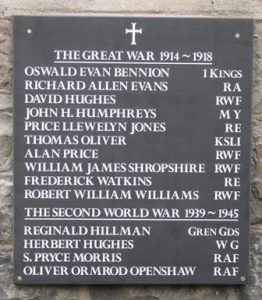
The Great War, 1914-1918
Oswald Evan Bennion, Private, 21684, The King’s (Liverpool Regiment). Oswald was the son of Charles and Elizabeth Bennion, of Berllan, Llanfyllin. He worked as a joiner at Liverpool prior to the war. Oswald enlisted at Liverpool into the 19th Battalion, King’s (Liverpool Regiment) on 26 September 1914. The battalion was raised in Liverpool by Lord Derby, and on 30 April 1915 moved to Belton Park, Grantham to join 89 Brigade, 30th (West Lancs) Division. On 6 November 1915 Oswald embarked for France with the battalion, and the entire Division moved to Buigny L’Abbe before assembling around Vignacourt by 18 November. The Division initially took over positions near Foncquevillers, but in the middle of January 1916 moved to positions in the Somme valley, taking over front-line trenches near Carnoy, where its infantry battalions began the usual routines of trench rotation, usually four days in the front line, four in support and four in reserve. The only breaks came when the various units were withdrawn from the front to undergo systems of training, in readiness for the forthcoming Somme offensive. At dawn on 1 July 1916 the 30th Division attacked from Maricourt, suffering heavy losses during the day as it captured its objective of Montauban. The Division held the line here over the coming weeks, as fighting raged along the Somme front. At dawn on 30 July 1916 the Division launched an assault from its new positions in Maltzhorn Trench, but suffered terrible losses before being forced to withdraw. Oswald was reported to have been wounded during the attack and was on his way back to the aid station, but was in the act of dragging another wounded comrade into the shelter of a shell-hole, when they got spotted by a party of Germans, who shot Oswald dead. The 19-year-old was originally buried where he fell by men of the 7th King’s (Liverpool Regiment), but his grave was lost during further fighting, so he is today commemorated on the Thiepval Memorial, France.
Elijah Thomas Biggs, Sergeant, 5320, King’s Shropshire Light Infantry. Elijah was the son of Elijah and Mary Biggs, of Iron Cottage, Sweeney Mountain. Elijah had originally enlisted into the Somerset Light Infantry in 1905, but by 1911 had left the army and was living at Ty Top, Llanfechain, where he worked as a Groom. As an Army Reservist, he was mobilised and posted to the 1st Battalion, King’s Shropshire Light Infantry, which was attached to 16 Brigade, 6th Division. The battalion had been in Tipperary at the outbreak of war, and had landed at St. Nazaire, France with the 6th Division on 10 September 1914. The Division then proceeded to join the BEF on the Aisne, before moving north to Flanders, and the Division took over positions near Bois Grenier. On 19 October 1914 the Germans launched a series of powerful attacks towards Ypres, intending to take the city, then reach the channel coast, forcing the Allies to surrender. The BEF, together with the French, managed to defend the city, but with heavy losses, and what was known as the Ypres Salient was then formed, with the city surrounded on three sides, north, east and south. The 6th Division, on the southern edge of the salient, saw heavy fighting at Bois Grenier, but managed to hold its positions during the coming weeks, and remained in the area over that first winter of the war. Elijah had embarked for France on 12 November 1914, and had joined the 1st KSLI in billets at Des Quatres Chemins on 15 November, just prior to the battalion taking over the line at Flamingerie Ferme on 24 November. The Division remained here until moving to the Armentieres sector on 3 January 1915, where it was to remain over the coming months. Elijah was wounded during a particularly hostile spell in the trenches here, and died of his wounds on 25 May 1915, aged 28. He has no known grave and is commemorated on the Ploegsteert Memorial, Belgium. Elijah is not commemorated on the Llanfechain war memorial.
Richard Allen Evans, Gunner, 245122, Royal Field Artillery. Richard was the son of Richard and Sarah Evans, of Godar Fach, Llansantffraid. He enlisted into the Royal Field Artillery at Llanfyllin, and was posted to B Battery, 293rd Brigade, RFA. The battery embarked at Southampton for Le Havre on 21 January 1917, as part of the 58th (London) Division, but was soon transferred to Army Troops. The battery saw its first major action at Bullecourt, during the Battle of Arras, that spring. The battery probably saw action at the Battle of Cambrai later that year, before wintering in the sector. On 21 March 1918, the Germans launched the first phase of their Spring offensive along the section of the front running south from Croisilles to La Fère. Richard’s battery was caught up in the desperate fighting which ensued, positioned near the village of Morchies. He was killed in action on that opening day of the offensive, 21 March 1918. The 34-year-old is buried in Beaumetz Cross Roads Cemetery, Beaumetz-Les-Cambrai, France.
David Hughes, Private, 55223, Royal Welsh Fusiliers. David was born on 20 April 1880, the son of Evan Hughes and Sarah Hughes (nee Jones), of Llanbrynmair. He married Catherine Thomas on 29 April 1901, and the couple lived at Cawy, Llanbrynmair, where their four children were born. David worked as a groom and chauffeur to Daniel Stable, at Plas Llwyn Owen, prior to enlisting in London into the Montgomeryshire Yeomanry. David was posted to France at the end of December 1916, and joined the 2nd Battalion, Royal Welsh Fusiliers, which was attached to 19 Brigade, 33rd Division. David was probably among a draft of reinforcements which joined the battalion at Vauchelles les Quesnoy at the end of December. In the middle of January 1917, the battalion moved into the front line at Clery, and remained in this sector until the beginning of April, when the Division moved to the Arras sector, taking over positions on the Hindenburg Line near Henin. The Division took part in terrible fighting here over the coming weeks, during the Battle of the Scarpe and at Bullecourt, before moving to the rest area at Airaines in July and then took over positions at Lombardzyde on the Flanders coast, where it prepared for a possible assault. By the end of August, it had become apparent that the Passchendaele offensive had stalled, so the 33rd Division was transferred to the Ypres Salient, and the 2nd RWF moved into the line near Polygon Wood by 25 September. On the following day the battalion attacked Polygon Wood in conjunction with an assault by the Australians, but suffered terrible casualties. David was wounded during the assault, and was evacuated to the Hospital at Lijssenthoek, where he died of his wounds on 28 September 1917, aged 37. David is buried in Lijssenthoek Military Cemetery, Belgium.
John Henry Humphreys, Quartermaster Sergeant, 903, Montgomeryshire Yeomanry. John was the son of Edward and Miriam Humphreys, of Llanrhaiadr. He married Hannah Hughes at Llangedwyn on 13 October 1883, and the couple moved to the Talbot Inn, Llanfechain. John was a long serving member of the Montgomeryshire Yeomanry, and held a senior position within the regiment, as Quartermaster Sergeant. Because of his age, he did not go to Norfolk with the front-line battalion of the regiment, was joined the 2/1st Battalion, Montgomeryshire Yeomanry, which had formed at Welshpool in September 1914. In July 1915 the battalion moved to Dorchester to join the 2/1st South Wales Mounted Brigade, and in September 1915 the Brigade moved to Southwold, joining the 1st Mounted Division. John took ill whilst based in Southwold, and returned home to Llanfechain, where he died of Bright’s Disease and heart failure on 8 January 1916, aged 57. He was buried with full military honours in St. Garnon’s Churchyard, Llanfechain on 11 January.
Edgar Jones, Private, 39148, Royal Welsh Fusiliers. Edgar was the son of Richard and Mary Elizabeth Jones, of Fron Goch, Llanfechain. He worked as a farm labourer at Plas Tregeiriog prior to enlisting into the Royal Welsh Fusiliers at Wrexham on 16 March 1916. Edgar was posted to Kinmel Park for training, before embarking for France on 15 July 1916, and joined the 5th Infantry Base Depot at Rouen. On 23 July 1916 Edgar was posted to the 2nd Battalion, Royal Welsh Fusiliers. The battalion was in tented camp at Buire-Sur-L’Ancre, where it was rebuilding following heavy losses during the attack on High Wood the previous week, whilst attached to 19 Brigade, 33rd Division. It was almost a month before the reorganised battalion was able to take to the field again, moving back to the line at High Wood on 18 August 1916, where the battalion endured a torrid tour in the trenches, suffering almost incessant artillery fire and beating off a German counter-attack. On 22 August the battalion moved into support positions on the Bazentin-le-Grand line, and took part in several minor operations before being relieved at the end of the month. The battalion then enjoyed a long spell out of the battle area, before taking over old trenches in Trônes Wood by 22 October, then took over Serpentine Trench, between Ginchy and Lesboeufs, beginning another torrid spell in the line. Edgar was killed in action near Lesboeufs on 3 November 1916. The 21-year-old has no known grave and is commemorated on the Thiepval Memorial, France. Edgar does not appear to be commemorated anywhere locally.
Pryce Llewellyn Jones, Sapper, 100768, Royal Engineers. Pryce was the son of John and Miriam Jones, of Llanfechain. He worked as a Carpenter prior to the war, and was living at 67, Milton Street, Southport, Lancs, when he enlisted into the Royal Engineers on 24 May 1915. Pryce was sent to the RE Depot at Chatham for his training, before embarking to join the Mediterranean Expeditionary Force at Salonika on 15 January 1916. Six months later he was hospitalised, suffering from gastro enteritis and bronchitis, and it was almost a month before he returned to duty. Pryce remained in Salonika for the rest of the war, but by the time he was discharged on 21 May 1919, his health had broken down. Upon returning to Britain, Pryce was hospitalised at Shrewsbury, where he died of pneumonia on 28 September 1919. The 33-year-old is buried in Shrewsbury General Cemetery.
William Thomas Langrick, Private, 290302, Royal Welsh Fusiliers. William was born at Ingoldsby, Lincolnshire in 1896, the son of William Thomas Langrick and Eliza Langrick. By 1911 the family had moved to 23, Valeswood, Little Ness, Shrewsbury, where William’s father worked as a gamekeeper. William himself worked at Ty Canol, Llanfechain prior to the war. He enlisted into the 7th Battalion, Royal Welsh Fusiliers at Llanfyllin on 3 September 1914, and was posted to Park Hall Camp, Oswestry to join the 3/7th Battalion, Royal Welsh Fusiliers. On 27 January 1916 William embarked at Devonport, for Egypt, joining the 1/7th Battalion, Royal Welsh Fusiliers, which was attached to 158 Brigade, 53rd (Welsh) Division. The Division had been evacuated from Gallipoli in December 1915, moving to Egypt to join the EEF, and helped guard the Suez Canal before taking part in operations to drive the Turks out of the Sinai. The EEF then turned its attention onto driving the Turks out of Palestine, and on 26 March 1917 launched its first offensive against the coastal city of Gaza, which guarded the road to Jerusalem. Initial gains during the day were lost when the assaulting divisions lost touch with each other and communication broke down when a thick fog cloaked the battlefield. William was wounded and captured by the Turks during the battle, and taken prisoner of war. He died in captivity, sometime between 11 April 1917 and 11 October 1917. The official date of his death is the latter. The 21-year-old has no known grave and is commemorated on the Jerusalem Memorial, Israel. He is not commemorated at Llanfechain.
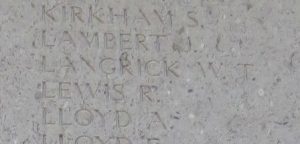
Henry Morris Oliver, Lance Corporal, 11703, Royal Welsh Fusiliers. Henry was the son of Pryce Oliver and Emily Phoebe Oliver (nee Reese), of 1, Castle View, Llanfechain. He worked as an iron moulder at Gresford prior to enlisting at Wrexham into the 3rd Battalion, Royal Welsh Fusiliers on 19 October 1911. Less than six months into his military career he was discharged as medically unfit, but later re-enlisted under the name of Morris Oliver, and joined the 1st Battalion, Royal Welsh Fusiliers. The battalion was at Malta when war broke out, and on 3 September 1914 sailed for England, joining 22 Brigade, 7th Division at Lyndhurst. On 7 October 1914 Henry landed at Zeebrugge with the battalion, but as the port was already falling to the Germans, the 7th Division made a long, forced march south, to Ypres, reaching the city by 15 October, and becoming the first British Division to hold the city. The Division then saw heavy fighting during the First Battle of Ypres, where it helped stop the German advance towards the Channel coast. The Division then took over the line around Le Touquet, where it wintered, in miserable, flooded conditions. In March the Division moved, handing over its trenches to the Canadians, and moved to the Laventie sector in time to take part in the Battle of Neuve Chapelle from 10-13 March 1915. At the end of April, the 1st RWF moved to billets in Merris, for a short rest, but a week later moved into the front line again, and took part in the Battle of Aubers Ridge on 9 May. Henry had been wounded during the terrible fighting for Aubers Ridge, and had been evacuated back to Britain, eventually being taken to the 2nd Western General Hospital at Manchester for treatment. He died of his wounds there on 10 June 1915, aged 21. Henry was buried in Manchester Southern Cemetery, and is commemorated on the Screen Wall, position Q. 398. One brother, George Pryce Oliver, had died at Malta on 21 November 1913, whilst stationed there with the Royal Garrison Artillery, and their eldest brother, Thomas Edward Oliver, died of wounds at Ypres on 12 February 1916. Only the one brother, Thomas, is commemorated on the Llanfechain war memorial, while Henry is not.
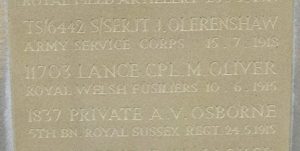
Thomas Edward Oliver, Private, 11660, King’s Shropshire Light Infantry. Thomas was the son of Pryce Oliver and Emily Phoebe Oliver (nee Reese), of Castle View, Llanfechain. He worked in the South Wales valleys prior to the war, and enlisted at Pontypridd into the 6th Battalion, King’s Shropshire Light Infantry soon after the outbreak of war. The battalion formed at Shrewsbury before joining 60 Brigade, 20th (Light) Division at Aldershot, then in April 1915 moved to Larkhill, Salisbury Plain to complete its training. On 22 July 1915 the battalion landed at Boulogne, and the entire Division moved to the St. Omer area, before being sent to the Outtersteene area, before taking over a section of the front at Sailly, in the Fleurbaix sector, for instruction alongside the 8th Division. When the Battle of Loos was launched on 25 September 1915 the Division fought a diversionary attack towards Fromelles. On 8 January 1916 the 6th KSLI was relieved from a routine tour in the trenches, and moved to billets near Hazebrouck, as the 20th Division had gone back into Corps Reserve. The Division underwent a scheme of training near Godewaersvelde, before moving back into the line on the Canal Bank at Ypres on 12 February. As soon as the 6th KSLI had taken over the front line that day, the Germans attacked the battalion to their left, whilst opening up an artillery barrage upon the Canal Bank lines. Thomas was wounded by shrapnel, and evacuated to the huge hospital at Remi Sidings, where he died of his wounds later that day, 12 February 1916. The 25-year-old is buried in Lijssenthoek Military Cemetery, Belgium. One of his brothers, George Pryce Oliver, had died at Malta on 21 November 1913, whilst stationed there with the Royal Garrison Artillery, and another brother, Henry Morris Morgan, died of wounds on 10 June 1915. Only Thomas is commemorated on the Llanfechain war memorial.
Allen Price, Private, 203104, Royal Welsh Fusiliers. Allen was the son of Richard and Elizabeth Price, of Llanfechain. His mother died when he was young, and his father went into Oswestry Workhouse, so Allen, his sister Helena, and a brother John, were raised by Mary Jones, at Prospect Road, Llanyblodwell. Allen enlisted at Llanfyllin into the Montgomeryshire Yeomanry on 19 September 1914, and was probably posted to Park Hall Camp, Oswestry for training. He embarked for France from Southampton on 17 December 1916, and was posted from the Infantry Base Depot at Rouen to the 1/4th Battalion, Royal Welsh Fusiliers on 5 January 1917. The battalion was the Pioneer Battalion to the 47th (2nd London) Division, and Allen joined the battalion at the Pioneer Camp at Ypres on 8 January. The battalion was at work laying light and broad-gauge railways in the Bluff and Railway Dugouts sectors. The Division took part in the Battle of Messines in June 1917, and then in November 1917 fought at the Battle of Cambrai. In March 1918 the Division was situated near St. Quentin, and faced the German Spring Offensive here on 21 March 1918, seeing heavy fighting as the front line was forced to withdraw over the coming days. The 47th Division finally reached Bouzincourt Ridge, where the German attack was finally held. The 4thy RWF were billeted at Senlis on 8 April 1918 when the Germans bombarded the area with gas shells. Allen suffered from gas inhalation during the bombardment, and was brought to the 5th London Field Ambulance for treatment, before being sent to the 56th General Hospital. On 27 April he was put aboard the Hospital Ship Newhaven and returned to Britain for further treatment. Upon recovering, he was posted to Ireland to join the 3rd Battalion, Royal Welsh Fusiliers, which had moved out on garrison duties, to help keep the peace. Sadly, Allen’s health had been shattered by his gassing, and he contracted influenza, dying in hospital at Limerick on 10 November 1918. The 27-year-old is buried in Limerick (King’s Island) Military Cemetery, Ireland.
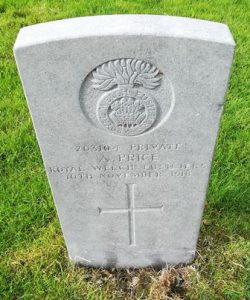
Thomas Edward Rowlands, Private, 355465, Royal Welsh Fusiliers. Thomas was born in Llanfechain in 1897, the son of Maurice and Mary Rowlands, and was baptised there on 21 February 1897. The family then moved to 3, Waenllys, Llanfyllin. Thomas worked as a railway porter prior to the war. He enlisted at Llanfyllin into the Montgomeryshire Yeomanry on 10 December 1915, and was initially placed on the Army Reserve, He was mobilised on 24 January 1916, travelling to Wrexham for his medical. Thomas embarked for Egypt at Devonport on 12 January 1917, and upon disembarking, was posted to the 1/1st Battalion, Montgomeryshire Yeomanry. On 4 March 1917 the battalion merged with the Welsh Horse Yeomanry to form the 25th (Montgomery & Welsh Horse Yeomanry) Battalion, Royal Welsh Fusiliers, as part of the newly formed 231 Brigade, 74th (Yeomanry) Division. The Division assembled in Egypt as part of the EEF, before crossing the Suez Canal into the Sinai, and saw its first major action during the Second Battle of Gaza. The battle was a failure, and the EEF was re-organised under a new commander, Sir Edmund Allenby, before launching the Third Battle of Gaza on the night of 31 October 1917. This assault was launched along a winder front, running from Gaza to Beersheba, and this time the EEF prevailed, opening the door to Jerusalem. The Division then took part in the drive north into Syria, but as a result of the heavy losses suffered in France, following the launching of the three German Spring offensives from 21 March 1918, was sent to France, landing in Marseilles on 7 May 1918. The Division underwent a system of training, to prepare it for the vastly different conditions on the Western Front, before taking over a section of the front in the St. Floris Sector. On 10 July 1918 the 25th RWF moved into the front line here for the first time, in the right subsector, covering St. Venant, for a long tour. Thomas was one of three men killed by enemy shellfire whilst in the line on 20 July 1918. The 21-year-old is buried in St. Venant-Robecq Road British Cemetery, Robecq, France. He is not commemorated on the Llanfechain war memorial, but at nearby Llanfyllin.
William James Shropshire, Private, 53659, Royal Welsh Fusiliers. William was the son of John and Fanny Shropshire, of Hendre Cottage, Llanfechain. He worked on his parent’s farm prior to the war. William enlisted into the Royal Welsh Fusiliers at Welshpool, and after completing his training, embarked for France in the winter of 1916, joining the 1st Battalion, Royal Welsh Fusiliers, which was attached to 22 Brigade, 7th Division. The Division was on the Somme, where it had suffered heavy casualties during the Somme offensive, capturing Mametz Village on 1 July 1916, before taking part in the Battle of Bazentin, and the Attacks on High Wood. The Division then took part in the Battle of Delville Wood, and the Battle of Guillemont, before spending the winter on the Ancre. William was possibly one of eight reinforcements who joined the 1st RWF on 23 October, while it was in the trenches, awaiting relief, and was posted to A Company. The battalion then went into reserve at Papot, until moving back into the trenches on 31 October. The battalion then began another tour in the Somme trenches before going back into reserve. On 25 November the battalion was still in reserve at Bertrancourt, when orders were received to move back into the line, and on 29 November the battalion relieved the 22nd Manchester’s in the right sub-sector at Beaumont Hamel. William was wounded during this latest spell in the trenches, and was invalided back to Mailly-Maillet, where he died of his wounds on 5 December 1916. The 23-year-old is buried in Mailly Wood Cemetery, Mailly-Maillet, France.
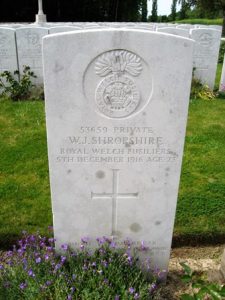
Frederick Watkins, Sapper, 325871, Royal Engineers. Frederick was the son of Job and Jane Watkins, of Groesnewydd, Llanfechain. He had enlisted into the Royal Engineers, and was posted to Bedford, joining the ‘A’ Recruits Depot, RE. Frederick was then posted to Ireland, and served there until embarking at Kingstown aboard the RMS Leinster on 9 October 1918, together with 693 other passengers, mostly servicemen and women, to return to Britain. On the following morning, 10 October 1918, Leinster was sailing east of the Kish Bank, bound for Holyhead, when it was struck by a torpedo which had been fired by the German submarine UB-123. The crippled liner turned around to attempt to get back to Kingstown, but was hit by another torpedo, which exploded and sank the liner. Frederick was among an estimated 564 people who lost their lives during the sinking. The body of the 19-year-old was later recovered from the sea, and he was laid to rest in Grangegorman Military Cemetery, Ireland. Nine days later, whilst returning to Germany, UB-123 struck a mine in the North Sea mine-barrage and sank with the loss of all hands.

Robert William Williams, Private, 355213, Royal Welsh Fusiliers. Robert was the son of Hugh and Catherine Williams, of Glanypwll, Bwlch-Y-Cibau. He enlisted into the Montgomeryshire Yeomanry at Welshpool soon after the outbreak of war. On 5 August 1914 the Montgomeryshire Yeomanry was mobilised at Welshpool, as part of the South Wales Mounted Brigade, before moving via Hereford to Thetford, to join the 1st Mounted Division. On 4 March 1916 the 1st Mounted Division sailed for Egypt to join the EEF. On 4 March 1917 the battalion merged with the Welsh Horse Yeomanry to form the 25th (Montgomery & Welsh Horse Yeomanry) Battalion, Royal Welsh Fusiliers, as part of the newly formed 231 Brigade, 74th (Yeomanry) Division. The Division assembled in Egypt as part of the EEF, before crossing the Suez Canal into the Sinai, and saw its first major action during the Second Battle of Gaza. The battle was a failure, and the EEF was re-organised under a new commander, Sir Edmund Allenby, before launching the Third Battle of Gaza on the night of 31 October 1917. This assault was launched along a winder front, running from Gaza to Beersheba, and this time the EEF prevailed, opening the door to Jerusalem. Robert had been badly wounded during the battle which followed, and he died of his wounds on 2 November 1917. The 23-year-old is buried in Beersheba War Cemetery, Israel.
World War Two, 1939-1945
Reginald Hillman, Guardsman, 2615895, Grenadier Guards. Reginald was born in Shropshire in 1921, but lived at Llanfechain prior to the war. He enlisted into the army and was posted to the 4th Battalion, Grenadier Guards. The battalion was among a number of new battalions raised for war between October 1940 and October 1941, and converted to an armoured unit, as part of the 6th Guards Tank Brigade Group. The battalion landed on the Normandy beaches in June 1944, and saw heavy fighting during Operation Bluecoat, then during the Battle for Caen, particularly in Operation Goodwood. Reginald was killed in Normandy on 14 August 1944. The 23 -year-old was originally buried on the battlefield, but after the war his grave was exhumed, and Reginald was buried in Bayeux War Cemetery, France.
Herbert Hughes, Serjeant, 2734669, Welsh Guards. Herbert was the son of Mabel Kathleen Morgan, of Bwlch-Y-Cibau. He enlisted into the army, and was posted to the 3rd Battalion, Welsh Guards. The Battalion sailed for North Africa on 5 February 1943, landing in Algiers eleven days later, then moved to El Aroussa, some twenty miles south of Medjez El Bab, where they joined the 1st Guards Brigade. On 9 April 1943, the 3rd Welsh Guards took part in an assault by the 1st Guards Brigade to capture the hills on the northern side of the Fondouk Gap, a feature about 1,000 yards wide through which passes the road to the coastal plain. The battalion came under heavy machine-gun and mortar fire, suffering heavy casualties. Herbert was killed in action during the days fighting. The 21-year-old is buried in Enfidaville War Cemetery, Tunisia. Herbert is not commemorated on the Bwlch-y-Cibau war memorial.

Samuel Price Morris, Flight Sergeant, 1503563, Royal Air Force Volunteer Reserve. Samuel was the son of John Thomas Morris and Mary Elizabeth Morris (nee Owens), of Tyddin, Llanfechain. He enlisted into the Royal Air Force Volunteer Reserve, and after training as a Navigator, was posted to 158 Squadron, RAF. The Squadron was equipped with the Vickers Wellington medium bomber at the start of the war, and in June 1942 re-equipped with the Halifax II heavy bomber, moving to RAF East Moor. On 6 November 1942 the squadron moved to RAF Rufforth, followed by a move to RAF Lissett on 28 February 1943. In January 1944 the squadron re-equipped with the Halifax III. Just after midnight on the morning of 20 February 1944, Samuel took off from RAF Lissett aboard Halifax III, Serial HX351, to take part in a raid on Leipzig. As the aircraft climbed it entered the clouds, before mysteriously plunging to earth, and her bombs exploded on impact, killing all her crew. It was thought that the carburettors may have iced up, causing the ill-fated aircraft to lose power. The remains of 21-year-old Samuel were recovered and brought home, and he was buried in St. Garmon’s Churchyard, Llanfechain on 29 February.

Oliver Ormrod Openshaw, Sergeant, 1215561, Royal Air Force Volunteer Reserve. Oliver was the son of Herbert Arthur Openshaw and Edith Jane Openshaw (nee Hetherington), of Brongain, Llanfechain. He enlisted into the Royal Air Force Volunteer Reserve, and was posted to No 10 Operational Training Unit, at RAF Abingdon for training as a Wireless Operator. On 8 February 1943, Oliver took off from Abingdon aboard an Armstrong Whitworth Whitley V, Serial LA784, on a night exercise. The mission was successfully completed, but on touch-down the aircraft bounced badly, forcing the pilot to lift-off again, before it crashed a mile from the airfield, killing Oliver and three of his fellow crewmen. Oliver was 23-years-old when he died that morning and his remains were brought home for burial in St. Garmon’s Churchyard, Llanfechain.